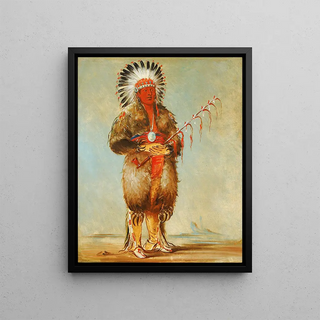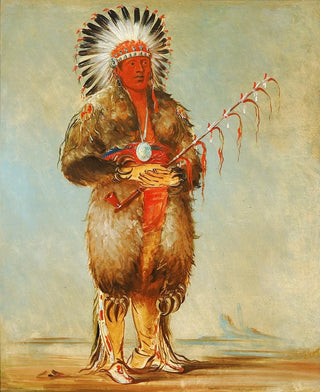Art print | Rw-No-Way-Wh-Krah Loose Pipestem un Brave - George Catlin


View from behind

Frame (optional)
In the fascinating world of 19th-century American art, the "Rw-No-Way-Wh-Krah Loose Pipestem un Brave" by George Catlin stands out for its boldness and depth. This painting, which captures the essence of a Native American chief, evokes not only the beauty of landscapes but also the richness of indigenous cultures. Catlin, as a witness to his time, was able to immortalize moments and characters that still resonate today with poignant strength. The art print of this work allows you to immerse yourself in a world where respect for traditions and cultural identities is highlighted, offering a reflection on the heritage of Native American peoples.
Style and uniqueness of the work
George Catlin's style is recognizable above all, blending realism and romanticism. In "Rw-No-Way-Wh-Krah Loose Pipestem un Brave," vibrant colors and meticulous details reveal not only the personality of the subject but also the environment surrounding him. The artist manages to create an immersive atmosphere, where the viewer can almost feel the energy of the moment frozen on the canvas. The chief's facial features, imbued with wisdom and dignity, are accentuated by a landscape that evokes the grandeur of the American plains. This work transcends a simple portrait to become a symbol of resistance and cultural pride, bearing witness to a time when identity was often put to the test.
The artist and his influence
George Catlin, born in 1796, is often considered one of the first artists to dedicate his career to the representation of Native peoples. His journey across the United States, where he met and documented various tribes, profoundly influenced his artistic vision. Catlin sought not only to capture the physical appearance of his subjects but also to understand their ways of life and traditions. His work played a crucial role in raising American public awareness of the richness of indigenous cultures, often little known or misunderstood. Through his paintings, he opened a window onto a disappearing world, prompting reflection on the importance of

Matte finish

View from behind

Frame (optional)
In the fascinating world of 19th-century American art, the "Rw-No-Way-Wh-Krah Loose Pipestem un Brave" by George Catlin stands out for its boldness and depth. This painting, which captures the essence of a Native American chief, evokes not only the beauty of landscapes but also the richness of indigenous cultures. Catlin, as a witness to his time, was able to immortalize moments and characters that still resonate today with poignant strength. The art print of this work allows you to immerse yourself in a world where respect for traditions and cultural identities is highlighted, offering a reflection on the heritage of Native American peoples.
Style and uniqueness of the work
George Catlin's style is recognizable above all, blending realism and romanticism. In "Rw-No-Way-Wh-Krah Loose Pipestem un Brave," vibrant colors and meticulous details reveal not only the personality of the subject but also the environment surrounding him. The artist manages to create an immersive atmosphere, where the viewer can almost feel the energy of the moment frozen on the canvas. The chief's facial features, imbued with wisdom and dignity, are accentuated by a landscape that evokes the grandeur of the American plains. This work transcends a simple portrait to become a symbol of resistance and cultural pride, bearing witness to a time when identity was often put to the test.
The artist and his influence
George Catlin, born in 1796, is often considered one of the first artists to dedicate his career to the representation of Native peoples. His journey across the United States, where he met and documented various tribes, profoundly influenced his artistic vision. Catlin sought not only to capture the physical appearance of his subjects but also to understand their ways of life and traditions. His work played a crucial role in raising American public awareness of the richness of indigenous cultures, often little known or misunderstood. Through his paintings, he opened a window onto a disappearing world, prompting reflection on the importance of






